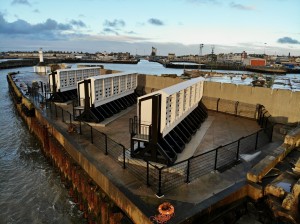Vattenfall and ScottishPower have unveiled the UK’s first kittiwake nesting structures to support consented offshore wind farms. The nests will be able to accommodate around 430 pairs of kittiwakes.
With advice from a group including representatives from Natural England, RSPB, East Suffolk Council and the Marine Management Organisation, the nesting structure has been designed to replicate the best conditions for nesting. It fact factors in conditions such as aspect, sunshine and shelter, and the size of the nesting shelves.
 Measures have also been taken to protect the nesting kittiwakes from predators: fencing at the bottom to protect against mammals like foxes and an overhanging roof to protect against aerial predators. While kittiwakes are known to be tolerant of human activity, the artificial nests are sited well away from the town and active port at the outer harbour to minimise interaction with human activity and property.
Measures have also been taken to protect the nesting kittiwakes from predators: fencing at the bottom to protect against mammals like foxes and an overhanging roof to protect against aerial predators. While kittiwakes are known to be tolerant of human activity, the artificial nests are sited well away from the town and active port at the outer harbour to minimise interaction with human activity and property.
The nesting structure is on land belonging to Associated British Ports, Port of Lowestoft and it was built by J.Murphy & Sons.
Separately, Vattenfall will also support and work closely with the Lowestoft Kittiwake Partnership. It has made a £50,000 a year funding commitment for five years to engage with and provide advice and support for local business and residents living alongside nesting kittiwakes, as well as money for cleaning up after kittiwakes, installing safe preventative measures to protect buildings.
A spokesperson from the Lowestoft Kittiwake Partnership said, “We’re delighted Vattenfall will be supporting the Lowestoft Kittiwake Partnership. As a globally threatened seabird, kittiwakes need our help to prevent them slipping further towards extinction, but in towns like Lowestoft which are home to urban nesting colonies in the summer we also need to think about how we manage the mess they make around their nesting sites and the impact this has on people and businesses. Vattenfall’s funding commitment will mean that we can pay for cleaning and other interventions to help people and businesses and enable kittiwakes to nest in more suitable locations, making life in Lowestoft better for the people who live there.”